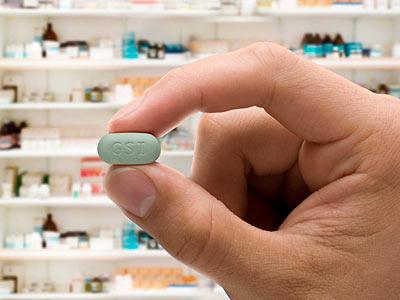Article
Stribild Offers Single-Tablet Treatment Option for HIV-1 Patients
Author(s):
Approved by the US FDA in August 2012, Gilead's Stribild is indicated to treat human immunodeficiency virus type 1 (HIV-1) infection in adults who have no prior experience with antiretroviral therapy.

Approved by the US FDA in August 2012, Gilead’s Stribild is indicated to treat human immunodeficiency virus type 1 (HIV-1) infection in adults who have no prior experience with antiretroviral therapy.
The complete once-daily, single-tablet regimen contains four compounds: 150 mg of the integrase strand transfer inhibitor elvitegravir, 150 mg of the pharmacokinetic enhancer cobicistat, 200 mg of emtricitabine, and 300 mg of tenofovir disoproxil fumarate (DF).
In a press release, Paul Sax, MD, principal investigator of one of Stribild’s two pivotal trials and clinical director of the Division of Infectious Diseases at Brigham and Women’s Hospital, in Boston, MA, said co-formulation in HIV medications has “simplified therapy for many patients and (has) become standard of care” over the past decade. Thus, Sax noted Stribild provides “physicians and their patients an effective new single tablet treatment option for individuals starting HIV therapy for the first time.”
Pharmacology and Pharmacokinetics
Following oral dose administration with food in HIV-1 infected patients, elvitegravir and cobicistat are both approximately 98 percent bound to human plasma proteins, while the in vitro binding of emtricitabine to plasma proteins is less than 4 percent and the in vitro binding of tenofovir DF is less than 0.7 percent, according to Stribild’s full prescribing information.
Both elvitegravir and cobicistat are metabolized by CYP3A enzymes, but while elvitegravir undergoes glucuronidation through UGT1A1/3 enzymes, cobicistat does not. Neither emtricitabine nor tenofovir DF is significantly metabolized.
Peak plasma concentrations after Stribild administration were reached “4 hours post-dose for elvitegravir, 3 hours post-dose for cobicistat, 3 hours post-dose for emtricitabine, and 2 hours for tenofovir following the rapid conversion of tenofovir DF.”
In a study comparing healthy HIV-1 infected patients to HIV-1 infected patients with either severe renal impairment or moderate hepatic impairment, no clinically relevant differences in elvitegravir or cobicistat pharmacokinetics were observed between the groups. However, for patients with renal impairment, “the pharmacokinetics of emtricitabine and tenofovir are altered in subjects with estimated creatinine clearance below 50 mL/min or with end-stage renal disease requiring dialysis.”
After coadministration with 100 mg of ritonavir, 94.8 percent of single-dose elvitegravir was excreted via feces while 6.7 percent was excreted in urine, and after multiple dosing of cobicistat for six days, 86.2 percent of single-dose cobicistat was excreted via feces while 8.2 percent was excreted in urine. Both emtricitabine and tenofovir were eliminated in urine via a combination of glomerular filtration and active tubular secretion.
Dosage and Administration
One fixed-dose combination Stribild tablet is administered orally once a day with food. Each film-coated dose of Stribild is green, shaped like a capsule, and debossed with “GSI” on one side of the tablet and “1” enclosed in a square box on the other side.
Clinical Trials
Stribild’s initial FDA approval was supported by two phase III, double-blind, active-control clinical studies of HIV-1-infected, treatment-naïve patients with baseline estimated creatinine clearance above 70 mL/min over the course of 48 weeks.
In the first study, 700 patients with a mean baseline plasma HIV-1 RNA of 4.8 log10 copies/mL and a mean baseline CD4+ cell count of 386 cells/mm3 were randomized to receive either once-daily Stribild or Gilead’s first FDA-approved HIV drug, Atripla (efavirenz/emtricitabine/tenofovir DF), once a day, and in the second study, 708 patients with a mean baseline plasma HIV-1 RNA of 4.8 log10 copies/mL and a mean baseline CD4+ cell count of 370 cells/mm3 were randomized to receive either once-daily Stribild or ritonavir-boosted atazanavir combined with Gilead’s Truvada (emtricitabine/tenofovir DF) once a day.
The results of the first study showed “the mean increase from baseline in CD4+ cell count at week 48 was 230 cells/mm3 in the Stribild-treated subjects and 193 cells/mm3 in the Atripla-treated subjects,” and at the conclusion of the second study, “the mean increase from baseline in CD4+ cell count at week 48 was 202 cells/mm3 in the Stribild-treated subjects and 201 cells/mm3 in the atazanavir + ritonavir + Truvada-treated subjects.”
Contraindications, Warnings and Precautions
Given that elvitegravir and cobicistat are both metabolized by CYP3A enzymes, the coadministration of Stribild is contraindicated with drugs that “strongly induce CYP3A which may lead to lower exposure of one or more components and loss of efficacy of Stribild, which may result in loss of virologic response and possible resistance,” as well as with drugs that are “highly dependent on CYP3A for clearance and for which elevated plasma concentrations are associated with serious and/or life threatening adverse events.” Additionally, Stribild should not be administered with drugs or regimens containing ritonavir, emtricitabine, tenofovir DF, or lamivudine.
As the safety and efficacy of Stribild in patients coinfected with HIV-1 and hepatitis B virus (HBV) have not been established, all patients with HIV-1 should be tested for chronic HBV before receiving initial dose of the antiretroviral therapy.
The most common adverse reactions to Stribild are nausea and diarrhea, though other adverse reactions include lactic acidosis and severe hepatomegaly with steatosis, new onset or worsening renal impairment, decreases in bone mineral density, and immune reconstitution syndrome.
For those reasons, prescribers are advised to assess patients’ creatinine clearance, urine glucose, and urine protein prior to initiating Stribild treatment and to monitor serum phosphorus in patients at risk for renal impairment and bone mineral density in patients with a history of pathologic fracture or other risk factors of osteoporosis or bone loss.



